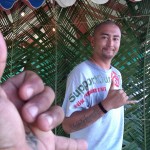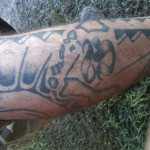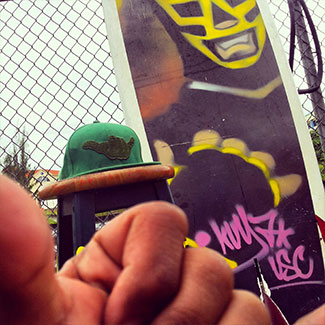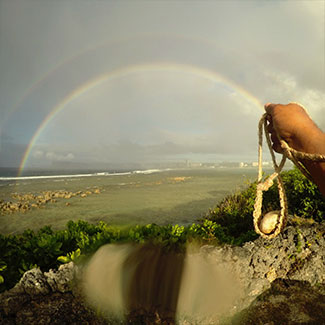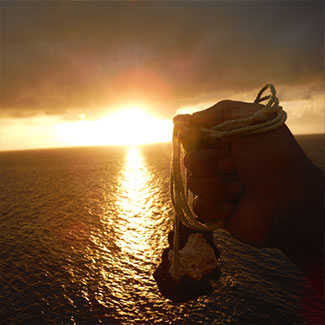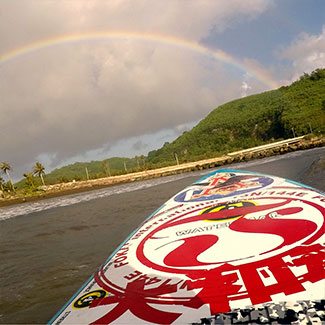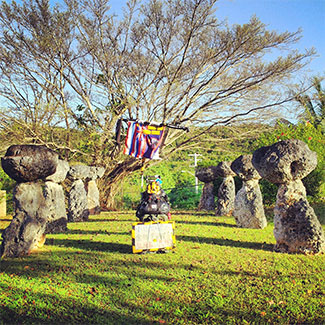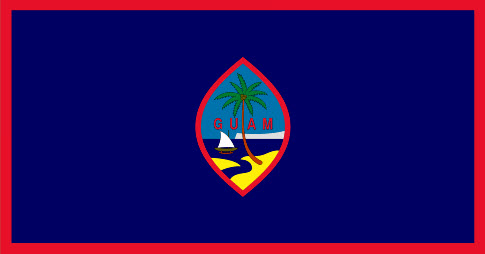PXC27:Report
November 11, 2011 by admin
Filed under Fokai International, GlobalGuamMMA
Cruz, Taimanglo victorious in PXC 27

Video Gallery

PXC 27 highlights5:24 |
by Dave Delgad
Baby Joe Taimanglo was awarded the unanimous decision win against Harris Sarmiento in the last fight of PXC 27. Baby Joe was all over Sarmiento for 5 rounds pinning him against the cage landing knees and punches. Taimanglo scored big on a hip toss that put the Hawaii Fighter on his head but couldn’t keep him on the ground. Sarmiento showed why he is the PXC’S 155-pound champion making Joe work for every position and not allowing Taimanglo to take the fight to the ground. The Hawaii Fighter did what he said by keeping the fight standing but didn’t have an answer to Taimanglo’s relentless clinch game. After 5 rounds the Juggernaut Baby Joe Taimanglo finally earned his first MMA Title with the decisive win against a very tough opponent becoming the island’s first 145-pound champion of the PXC.
GuamBJJ:Carbullido&AyuyuAgain
November 9, 2011 by admin
Filed under BJJ Stuff, Fokai International, Onra
Ayuyu, Carbullido capture gold
3:00 PM, Nov. 8, 2011 |
Mike Carbullido, right, gets his hand raised by the referee after winning a match in the blue-belt division of the 16th US Open BJJ Tournament held Oct. 15-16 in San Jose, Calif. / Photo courtesy of Pete Ulatan
Miguel Ayuyu, bottom, secures an armlock on his opponent. / Photo courtesy of Pete Ulatan
Former Guam residents Miguel Ayuyu and Mike Carbullido continue their climb up the ladder of Brazilian jiu-jitsu as the pair recently notched gold medals at the 16th US Open BJJ Tournament that took place on Oct.15-16 in San Jose, Calif.
Competing as blue belts, Ayuyu placed first in the lightweight division and Carbullido topped the medium heavyweight division. The US Open marked the sixth tournament Carbullido has participated in this year and he does not intend to slow down. His sights now are focused on the World Jiu-jitsu No-Gi Championship set for this weekend in Long Beach.
“I want to make it as far as God is willing to take me,” Carbullido said via email from San Diego.
Ayuyu also is preparing for the no-gi championships and added that BJJ has become an integral part of his life. “I’ve been doing jiu-jitsu for six years now and I’ve worked hard to get where I am [so] quitting now would be the worst decision I could make,” Ayuyu said via email.
Just over a year ago the former Carlson Gracie Jr. Academy students and graduates of George Washington High School decided to relocate to southern California in order to pursue their BJJ dreams.
Multiple tournaments and several gold medals later, it appears as if the move has paid dividends. Ayuyu said regularly training with world champions and high-level BJJ players has taught him a lot about the martial art. “Moving to the states has really brought my game to another level,” Ayuyu said.
In addition to receiving top-notch instruction, the deeper pool of competition and frequency of tournaments allows Carbullido more opportunities to test himself. “I’m able to get [into] big, worldwide tournaments easier with me being out here compared to being on Guam,” Carbullido said. “I’m able to concentrate more and train harder.”
The dreams of BJJ glory, however, do not come to fruition without challenges and trials. When asked what the most difficult aspect of constantly training and competing is, Ayuyu simply said, “Bills.”
Motivation
Carbullido added that it wasn’t easy to leave his family and to pursue his dream, but he knows the rewards are worth it. “I always remind myself of all the sacrifices and dedication I’ve put in over the years,” Carbullido said.
“The fact I can’t be with my family and my sister, the fact I can’t eat red rice and deer keleguan whenever I feel like it. All those reasons push me to never give up no matter the struggle.”
Carbullido thanks his mother Pilar, his sister Mikenna and the rest of his family for their support. He also thanks Gabe Baker, Byron Evaristo, Beachwood/Fleetwood San Diego, Nakama Brand, Apparatus Jiu-jitsu, Cars Plus and the people of Guam.
Ayuyu thanks the people of Guam, as well as Baker and Moya Brand
Warrior’sSacrifice:TheEnsonInoueStory
November 4, 2011 by admin
Filed under Familia, FokaiCombatUNit, Special Forces
November 1, 2011, 11:03 am
BY EVAN ROSSER
Sportsnet magazine
Enson Inoue is in the passenger seat of a truck driven by his friend Jin Watanabe as it picks its way through the empty streets of the 20-km evacuation zone surrounding the damaged Fukushima Daiichi Nuclear Power Plant. It’s late August 2011, less than six months after the Tohoku earthquake and tsunami shattered, razed and extinguished the northeast coast of Japan, killing more than 15,000 people and displacing hundreds of thousands. With the help of Watanabe, a contractor working inside the zone, and a fake security pass, Inoue is on his second trip in.
As their truck makes its way deeper into the evacuated area, past blasted homes, vacant parks and cleaned-out stores, the only visible sign of life is the occasional cat or dog, left behind by its owners, scavenging by the side of the road. The truck pulls to a stop for each one and Inoue climbs out and retrieves a bucket from the back. It contains a slop made from a mixture of wet and dry dog food that he portions out over the course of the day. The cats eat it without objection; the dogs with undisguised joy. These animals are the reason Inoue is risking his health to return to one of the most desolate and irradiated places on earth. The last time he came, he had no food for them. It made him feel empty.
The abandoned animals of Fukushima are part of a larger mission Inoue has undertaken to bring aid and support to the victims of the Tohoku disaster. It’s a cause that has required him to put his life at risk, but Inoue has always shown alacrity in that regard. As one of the most exciting and respected mixed martial artists of his generation, he was celebrated for his willingness to die fighting. When he was young, this need to test his own limits was expressed in a senseless readiness to kill or be killed in the street, but once focused in the ring, it earned Inoue the title Yamato-damashii, a term that is often used to describe warriors, and for better or worse, Inoue has always been a warrior. There was a time when losing his life in the ring would have been the final proof of his honour and manhood. But in the north of Japan, helping the displaced rebuild their lives, Inoue has finally found something truly worth the sacrifice.
• • •
Though he managed to get himself in a consistent string of street fights from middle school onwards, Inoue didn’t become a real fighter until he was 27. Born in Honolulu in 1967 to schoolteachers Errol and Evangeline, his first sport was racquetball. He lasted two years on the professional tour before moving to Japan in 1990 to fill in for his older brother, Egan, at an amateur tournament. After deciding to stay in the country, he won four straight national championships. Then he walked away from the sport, and dedicated himself to something entirely different.
In late July 1994, Inoue attended the first Vale Tudo Japan—a mixed martial arts tournament that ran annually until 1999. He was there to watch Rickson Gracie fight. Inoue had spent a year training in Brazilian jiu-jitsu under Rickson’s brother Relson while taking courses at the University of Hawaii. He had always considered martial arts to be a hobby, but as he watched Rickson in the ring, something changed. “When I saw him fight,” Inoue explains, “the anxiety that I felt was far greater than at any racquetball tournament I ever played—just watching him fight.” Before Gracie’s match was over, Inoue knew he had to feel what it was like to be in the ring. Even if the fear completely overwhelmed him, he had to know whether he could endure it.
He called every MMA organization in Japan, but most had strict admission requirements. The only organization willing to give him a shot, Inoue says, was Shooto. Told to “come on down to the gym and spar,” Inoue jumped at the opportunity. With ex–pro wrestler and Shooto founder Satoru Sayama looking on, he was put in the ring with Yuki Nakai, a fighter with a 5-1 professional record. “I out-positioned him, mounted him, got his back, did everything to him,” Inoue recalls. The display was striking enough to earn him a fight on the spot. “I didn’t care if it was amateur or pro, small ring or big ring,” he says. “I wanted to feel hand-to-hand combat, man-to-man—the jitters.” Though he was only interested in testing himself in a single fight, the match Inoue agreed to was his professional debut. He had three months to prepare.
• • •
The last time Inoue had fought on three months’ training, the circumstances were a little different. It was 1989, and he had tagged along with Egan to the U.S. national racquetball championships in Seattle, Wash. Late one night, the brothers and a friend were driving around taking in the city. Stopped at a set of lights, they struck up a conversation with a car full of girls and got themselves invited to a nearby club. When the light flicked green and the girls made a left turn, they followed suit from the centre lane and were hit by a third car.
Special magazine trial offer: Sign up for four FREE issues of Sportsnet magazine and get a discounted price on a subscription. Satisfaction guaranteed. Order now!
As the three collected themselves and got out to check on the other car, its driver was already heading their way, yelling colourful promises to do to them roughly what had been done to his vehicle. “We were getting attacked by this guy who was the size of all of us put together,” remembers Egan, who had extensive martial arts training. “I looked at this guy and thought, ‘I don’t know if I could hurt him hitting him.’” As Egan ran to a pay phone to call the police, Inoue, who had only been training at Relson Gracie’s gym for three months, followed his instincts in the only direction they ever led—straight into conflict.
The man jabbed his fingers into Inoue’s chest, spitting curses. Inoue told the man to calm down and wait for the police, but inside he was already bristling. When the driver poked him for a third time, he let himself go.
Taking the larger man’s outstretched arm in both hands, Inoue turned and wrenched it forward and down, bringing the driver over his hip and sharply to the ground. They struggled on the asphalt, Inoue landing a series of punches to the man’s face, head and throat that had no discernible effect. With Inoue on top of him the driver rolled onto his stomach and attempted to stand. Inoue slipped an arm over the man’s shoulder and wrapped it around his neck, choking him from behind with his forearm. The man launched himself backwards, crashing to the ground and pinning Inoue beneath him. He clawed at Inoue’s eyes, fighting for air. Soon, he was unconscious.
Worried the big man would get back up, the trio fled. The jiu-jitsu had worked, Inoue realized in a rush of excitement, but as they drove away he could see the man’s body in the rear-view mirror, still unmoving. He stopped worrying about the man getting back up and for the first time started worrying that he wouldn’t. He spent the next day scanning the papers with Egan, looking for mention of the incident. They didn’t find any.
• • •
When Inoue first appeared on the Japanese MMA scene six years after the Seattle incident, Brazilian jiu-jitsu was “the art of arts,” says legendary mixed martial artist John Lewis, who eventually gave Inoue his black belt in the discipline. Inoue’s arrival coincided with the rise of Royce Gracie in the UFC. As Gracie put the true potential of Brazilian jiu-jitsu on display, dominating a long line of larger fighters from a wide range of martial arts backgrounds, fight fans and insiders in North America began to take notice. Largely cut off from that world, however, Japanese fighters were much slower to make the transition to jiu-jitsu-based grappling. “Shoot wrestling [the backbone of the Shooto organization] had nothing to do with ground positioning,” Inoue explains. “It was all about submissions.” It wouldn’t take him long to show them the value of striking on the ground. Inoue still had very little training beyond his single year with the Gracies in Hawaii. In the lead-up to his first fight in January 1995, his opponent, fellow first-time pro Shingo Shigeta, couldn’t see past Inoue’s limited martial arts background. Loud, cocky and crowing, he predicted an easy victory. The implication that Inoue would go down without a fight was, in Inoue’s view, the gravest of insults. “He got Enson into that mode that Enson was going to kill the guy,” Egan recalls. “It would have happened, too, if there was no ref.” The 70 seconds of unabated ass-kicking Inoue unleashed on his opponent to earn his first victory by TKO comprised the full extent of Shigeta’s professional career. He never set foot in the ring again.
A lightly promoted undercard, that first fight shouldn’t have drawn much attention. Instead, says Inoue, there was a full-page write up on the big American “monster of Japanese descent that knows Gracie jiu-jitsu.” Inoue was flattered. He felt the coverage obligated him to fight at least once more. The same sense of responsibility carried him through his first four professional fights—all victories.
The fourth—against four-time world kick-boxing champion, Andre Mannaart—was a turning point. “When I took [Mannaart] down and beat him, it kind of rang bells in my head like, ‘Wait a minute, maybe I am good at this,’” says Inoue. “I changed my whole thinking and went full-time into training.”
• • •
On his back in full guard on a canvas mat Pollocked with blood from an earlier fight, Enson Inoue takes a few seconds to think, with Randy Couture’s forearm pressing down on his neck. It’s October 1998, moments into the first round of a fight Inoue is expected to lose. He has spent less than 20 seconds on his feet, but has yet to take any real punishment. The fighter’s instincts he’s always had remain, but years of technical training have refined them into an art.
Couture releases the pressure from Enson’s throat and gets both hands up by his head, feeling around, searching for a way to inflict enough pain to slip Inoue’s guard. Leaving his head unprotected, Inoue manoeuvres himself sideways underneath his opponent. Then he waits to get punched in the face.
It doesn’t take long. Couture plants his off-arm on the mat and drives his left fist into the right side of Inoue’s face. Inoue is already in motion when he gets hit, wrapping himself around Couture’s right arm. Taking the wrist in both hands, he pulls Couture’s arm straight and then past straight, bending it back at the elbow and sending nauseating waves of pain up to Couture’s shoulder. The tapping on Inoue’s leg comes fast and urgent. The fight is over a minute and 39 seconds after it began.
Couture—the future UFC Hall of Famer, undefeated at that point and fresh off his first heavyweight title—is the most famous, and maybe the most skilled, fighter Enson Inoue ever beat, and for that reason those 99 seconds on the mat have been held up as the pinnacle of Inoue’s martial arts career. But it’s the way he beat Couture that hints at the kind of fighter Inoue was, and the kind of man he remains—using his face as bait, risking injury and defeat to create the opportunity necessary to win. In that moment, Inoue displayed a central tenet of Yamato-damashii—total indifference to one’s physical well-being in the name of a higher purpose.
It’s a wilful disregard for his own safety Inoue seems to have been born with. When they were children, Egan decided early on he would rather go to elaborate lengths to avoid a confrontation than fight his brother. Older by two years, he was never worried about being hurt, but the beating he had to lay on Enson to finish the fight was more severe than anything he was willing to inflict on his own flesh and blood. “With Enson I think it’s more than just stubbornness,” he says. “It’s really that samurai, willing to die for his cause.”
• • •
Inoue’s fearlessness in the ring struck a particular chord with the Yakuza—Japanese organized crime. According to him, it’s common for Japanese martial artists to be approached by members of the Yakuza after a match. “With my status as a famous MMA fighter, it’s understood that I would have connections,” Inoue explains. “But my reputation went a little further than that as far as mingling with them and becoming very good friends with a lot of them.”
Since his retirement from active fighting in 2004, Inoue’s continued popularity in the Japanese underworld has allowed him to make most of his living by attending and occasionally judging Yakuza-run underground fighting events. He is particularly useful for defusing the frequent riots that break out when the crowd disagrees with what takes place in the ring.
Scheduled to attend an underground fight in Tokyo at the end of March, Inoue was at his home in Saitama, a short drive north of the capital, when the Tohoku earthquake hit. Unhurt and with his house largely undamaged, he fled south to Kyoto after a friend in the military told him of the leak at the Fukushima plant.
In Kyoto, he learned that the Tokyo fight was off. Its organizers had all gone north to take supplies and assistance to the disaster area. “They were there before the army,” Inoue says.
He was floored. “I sat there thinking, ‘Oh my God, I just ran the other way.’” The shame of having fled came first, but the persistent thought that he was meant to help the victims was harder to get out of his head. “I knew that I had to go up there,” he says. He filled his truck—a black Hummer—with water, rice and other basic necessities. Two weeks after the earthquake and tsunami hit, alone and with no clear idea of the extent of the danger and devastation he would face, Inoue drove to the aid of the people of Tohoku.
The traffic thinned as he headed north. Eventually, the only other vehicles he encountered were military trucks ferrying groups of soldiers. For the most part, the roads had been cleared of heavy debris and were navigable. The military had made that top priority—ahead of clearing the dead. “I felt like I was driving through a movie,” Inoue recalls. “There were still bodies in the trees, there were bodies floating in the water.” At one point, driving past a gas station, he noticed a body draped on the edge of the roof above the pumps. It was easily 20 feet from the ground. The buoyancy and purpose he’d felt knowing he was on his way to help people in need quickly faded. “I had a reality check,” Inoue says.
Even more shocking than the remains of the dead was what was left of the places where they had once lived. In many areas, rubble was piled as high as two storeys on either side of the road. Where entire neighbourhoods and towns had once stood, there was nothing. The force it must have taken to level and sweep away so much humanity was mind numbing; the fear that must have been experienced by the people caught in its path was unimaginable. Inoue drove on in silent disbelief.
He had been asked to check on Futoshi Hatakeyama, a friend of a friend who lived in the coastal city of Miyako in Iwate prefecture. Arriving at Hatakeyama’s home, he found it in near-ruins. He offered to help clean up, repair or rebuild in any way he could, but he was politely refused. His offers of food and water were also turned down. “Honestly,” Hatakeyama said, “it’s better if you drop it off at the evacuation centres. They’re in much more need.”
At the nearest centre, Inoue was directed to a building across the street where volunteer workers unloaded his truck. Exhausted and emotionally drained after days in transit, he watched the entirety of his cargo disappear in 10 minutes. Instead of feeling satisfied, he felt nothing. “The food and water was gone and I didn’t personally give it to a single person,” Inoue recalls.
“That’s it?” he asked, turning to Hatakeyama, who had guided him to the centre. “We’re not going to see them give it to the people? See the people drinking the water?” Hatakeyama offered to take Inoue to a smaller evacuation centre. His family was living there and he told Inoue they would be able to walk through.
Inside, Inoue instantly felt like a trespasser, one of the unaffected, there to observe the misery of people who had lost everything. Keeping quiet, he did his best to figure out which supplies the centre most desperately needed. He settled on hand soap and water. Then he left.
With the condition of the roads, it was a three-and-a-half-hour drive to the closest town that had enough soap and water to fill Inoue’s truck. He made the trip that night and returned the next day. People continued to keep their distance and he was unsure how they felt about him. “There was this old man who came up to me and said, ‘Do you have any cigarettes?’” remembers Inoue. He didn’t, but promised to come back the next day with a few cartons. That night, he again made the seven-hour round trip, returning the following morning with the smokes. “I got mobbed by the people,” Inoue says. “That kind of broke the ice.”
Curiosity is Inoue’s greatest enemy in the north. It pulls him away from the relative safety of the evacuation centres and out into the eroded remains of hospitals, stores and banquet halls, where the air is laced with asbestos and even a small aftershock could cause any of the already-damaged structures to collapse in on him. And despite reported levels of radiation high enough to render stretches of the area uninhabitable for decades, curiosity is also what first lured him into the Fukushima Daiichi nuclear evacuation zone.
“The public had become skeptical about the government’s report on the radiation issue,” says Jin Watanabe, speaking through a translator. “Enson wanted to find out the truth, in his own way.” Inoue’s “own way” involved convincing Watanabe to sneak him through a security checkpoint. Had they been caught, then or at any time while in the zone, Inoue would have faced imprisonment and deportation.
For that first trip in, he took a dosimeter—a device that measures absorbed doses of radiation—but couldn’t get his hands on a proper radiation suit. Instead, he wore a rain jacket over his clothes. Unable to see or feel the radiation—which, in the aftermath of the disaster, had been measured at levels high enough to change blood chemistry in an 80-km radius around the plant—both men experienced it as an ever-present sense of unease. Deciding they were safer in motion, Watanabe refused to stop the truck. They drove around, Inoue becoming increasingly distressed at the sight of all the stray animals, until Watanabe could no longer handle the strain. Then they left.
In the seven months since his first trip, Inoue has returned to the Tohoku region 10 more times, staying anywhere from three to 10 days per trip. He has visited as many as 12 different evacuation centres and delivered tens of thousands of dollars worth of food, clothing and diversions, ranging from ice cream to books to bottles of wine. Divorced since 2004, Inoue’s only tie to the house in Saitama is a small zoo’s worth of exotic pets. When he began his missions in March, he had to pay as much as $700 a trip to board a pair of monkeys and an albino garden snake. It hasn’t been as hard to talk friends into feeding his piranhas and turtle.
Initially funding everything out of his own pocket, Inoue has converted a pre-existing business—handmade bracelets he sells online under the name Destiny Forever—into a charitable venture in order to afford the missions. He’s currently planning his next trip for the middle of November.
• • •
For the time being, Tohoku is about as far as Inoue can go. On Oct. 18, 2008, he was sitting in a parked car when two police officers approached and asked to search the vehicle. They turned up nearly 17 grams of marijuana secreted in the sunroof, door compartments and on Inoue’s person. Never able to sleep more than three or four hours a night, Inoue turned to weed a few years after retiring from the ring. If he smoked, he could sometimes manage seven hours of sleep.
In Japan, the punishment for drug convictions is severe. “I’ve been here 21 years and I knew it was just as bad as holding cocaine,” says Inoue. He was found guilty of possession of marijuana and spent 26 days in jail. Never having become a Japanese citizen, he only avoided deportation thanks to a petition signed by more than 9,000 fans.
Rebuilding his reputation has been difficult. At the time of his arrest, Inoue says, footage of him in handcuffs was broadcast on every national television channel, and since his release, he has been blackballed by the Japanese media, who he believes are afraid of losing advertising dollars for appearing to glorify a criminal. Inoue felt the need to prove that he had learned from his mistakes. So in May of 2010, at the age of 43, he got back in the ring.
“I only had a month to prepare,” Inoue says. “I was fat and out of shape.” Still, he had a point to prove. “If I’m fighting in the ring, it means I got drug-tested,” he explains. “I wanted to show the people that I’m back. Here I am, I’m sorry for what I did.” Inoue fought Antz Nansen, a kick-boxer from New Zealand who is 16 years his junior. Looking almost nonchalant on his feet in the striking stage, Inoue brought Nansen to the canvas in just over a minute, mounted him in under two and at 2:10 in the first round, submitted him by armbar.
• • •
Detained in Japan on probation until December of this year, Inoue is entering a transition period. Though he won’t rule out the possibility, it seems unlikely he’ll ever fight again. He continues to train, but his true place is no longer in the ring, it’s with the people of Tohoku. The recovery effort has advanced to the point that the displaced are being moved from the evacuation centres into temporary housing. The move offers the victims of the Tohoku earthquake and tsunami their first real personal space and privacy since losing their homes. Inoue is acutely aware of that and anxious not to intrude. “You don’t want to knock on the door,” he says. “You try to wait for someone to pop their head out and you kind of talk to them.”
At the same time, unlike the evacuation centres, the temporary housing doesn’t cover peoples’ basic needs. With no way of providing for themselves, many new residents are back where they were seven months ago—desperately in need of things as simple as soap and water.
When he figures out how, Inoue will be there for them. His garage, originally outfitted as an MMA training centre, has been given over to his new cause. It now functions as a storage unit for food and other necessities. “It’s become almost like an obsession to get these smiles and thank yous,” he says. “A lot of people say, ‘You’ve got to live your own life,’ but I’ve found that in a way, this is living my own life.” And maybe that is what he’s been looking for all along. Always willing to die in the name of his honour and manhood, Inoue has come to feel that such sacrifices are worth much more if they are offered for the sake of someone else.
MartialArts?
November 2, 2011 by admin
Filed under Special Forces
Borrowed from www.guampdn.com…
A man wearing a mixed martial arts T-shirt allegedly threatened to stab another man wearing a competing mixed martial arts T-shirt in a local restaurant, according to a declaration filed in the Superior Court of Guam.
Alliance
Dana Lance Leon, 35, was charged with assault as a misdemeanor. At approximately 3 a.m. on Sunday, Leon was sitting at Linda’s Cafe in Tamuning wearing a T-shirt supporting a mixed martial arts alliance. A second man entered the restaurant wearing a T-shirt supporting a different mixed martial arts alliance, according to the declaration.
After entering, the second man began talking to Leon, who “had no interest in talking with the man and thought the topic had become invasive, especially given their different martial arts allegiances,” the declaration states.
Off-duty officers
Leon allegedly stood up, and grabbed a seven-inch steak knife from the table. He allegedly held it over the second man’s head in a stabbing position. Two off-duty police officers heard the commotion and subdued Leon, according to the declaration….
nekotnedlogeht:BotanicalForest
October 24, 2011 by admin
Filed under Nekotnedlogeht
Product:FokaiSummerBreakerJacket2011
October 24, 2011 by admin
Filed under Product Development, ProductDevelopment
VideoDetails on features of the Fokai2011SummerbreakerJacket
PXCShowcasesGuamMMA
PXC 27 showcases growth of MMA in Pacific Rim
8 hours ago | source: pacificxtremecombat.com | 4348 Views | 5 Comments
Mixed Martial Arts is driven by passion. The fans are so passionate they levitate. Fighters are so passionate they got locked in a cage, to fight. Some of the greatest events in the history of the sport happened because of a rare breed of fan – very, very rich people. Lorenzo Fertitta took BJJ from John Lewis, and eventually bought the UFC. Shaik Thahnoon took BJJ in graduatge school, and ended up founding the ADCC world submission wrestling championship, and 10% of the UFC.
The Calvo family is the Guamian equivalent, and a decade ago when a young member fo the family, one again, took BJJ, the family decided to get into the MMA business.
From the first show in 2003, Pacific Xtreme Combat(or PXC) airs its 27th and largest show October 29th at the University of Guam Field House.
After huge rating success with its first two Philippine cards, Pacific Xtreme Combat will return to its home base of Guam with the blockbuster event PXC 27 which will feature a stacked card and two title fights.
“PXC 27 is the culmination of all of our company’s hard work through the years. It will serve as a premier showcase for our company by providing the best quality match-ups. PXC 27 will feature two championship fights; a 145-pound tussle between Baby Joe Taimanglo (Guam’s most recognized fighter) and Harris Sarmiento the current PXC 155 pound champ, plus Justin Cruz will be defending his bantamweight title against the young and impressive Trevin Jones,” says PXC Matchmaker Eli Monge.
In addition to the two title fights the card will showcase a who’s who of the best fighters from the Pacific Rim region.
“We are really laying it all out there for the people of Guam,” says Eli, “The caliber of the fighters on this card is incredible. We have Ferrid Kheder who has defeated some UFC veterans in the past, going against Korean Top Team member and UFC hopeful Lim Hyun Gyu. We also have J.J. Ambrose, who is an alumnus of The Ultimate Fighter, and is coming back to take on a strong international opponent.
The Pacific Rim is one of the hottest places in the world for mixed martial arts and PXC is leading the way, growing the sport in that region. In June PXC expanded its long time successful Guam promotion by signing a major television deal with TV 5 in Manila. The first two shows were huge ratings successes and opened eyes as to the potential of the sport in the Philippines. PXC will not let success or rapid expansion detract from its original mission, which is to bring high quality mixed martial arts events to and support the sports growth on the island of Guam.
Onra:OCtober20th,2011
Hafa Adai,
Congratulations goes to Spike 22’s BabyJoeTaimangalo for his bronze medal finish in the 70kg no gi division of the 2011 FILA Senior Grappling World Championships in Serbia.
Further congratulations also goes to Purebred/Lloyd Irvin Jiujitsu’s Aileen Wong for becoming the Tokyo International Open jiujitsu tournament’s -53.5kg & Absolute Blue Belt Champion!
The GUAM OPEN MARTIAL ARTS TOURNAMENT is still looking for more competitors for their two-day event with a SPARRING & FORMS COMPETITION on Saturday, November 5 at 12:00pm – and a Jiujitsu tournament on November 6 at 9:30am. Details and registration available via guahankenpo@yahoo.com.
The135lb. & 145.lb championship titles will be at stake as a stacked fight card is in the works as Guam MMA returns to the UOG Fieldhouse in PXC27 on October 29th.
Considering recent headlines, both local and international, it’s amazing to see how Mixed Martial arts has weaved its way into the community.
For something that had been in the past regarded in many ways as taboo—Professional full-contact fighting has emerged valiantly from the underground to the fast lane with multiple intersections and merges between athletics, industry, and lifestyle.
From the Gracie Family’s primary intentions to identify the superior single martial art to million-dollar contracts more often being finalized with today’s most marketed MMA athletes. From the long adventures and lure of training with the mystical old man in the mountains to the tens of thousands of free online instructionals for highly-refined and battle-proven techniques, strategies, and conditioning.
The sophistication of “Mixed Martial Arts” as we now call it, not only offers skill at our fingertips, it also offers options of career building opportunities within its industry and sport for its large number of fans who have gravitated towards it
The myth and mystery of secret technique has largely been replaced simply by hard work and well-rehearsed fight strategy that has evolved our world’s best today arguably into the greatest empty-handed fighting machines in the long line and history of warriors and martial artists. The undefeatable have been defeated, the irresistible force has been resisted, and the immovable object has been moved.
Though, in many ways, the old mystique of martial arts might have lost some pulse—still nothing takes away from today’s not-so-silent martial artist’s ability to affect their environment positively.
Did you hear about Frankie Edgar being called in not once but twice as a motivational speaker for the New York Yankees? Or have we read about Enson Inoue’s many and still-ongoing expeditions to service victims of Japan’s March 11 Tsunami? When considering how many countless other fighter athletes have recycled any clout given to them through MMA sport and industry into volunteer work and community service– It’s uplifting to hear that the greatest of our fighting champions have been able to put aside heavy hands and take light-hearts to plug MMA as a positive variable in a much larger equation than “who is the best fighter in the world?”
Next weekend at the University of Guam Fieldhouse we will be coming into the 27th edition of PXC, along side the other 20or so shows they might have produced—on Guam there has been multiple editions of SuperBrawl, Jungle Rules, Fury, Spike22FightNight and GeranHaga. Between the headlines of how many thousands showed up for the events, how exciting the fights were, the fastest knockout, or best submission—what other conversations have we given—how many conversations are we giving–the general public to speak of?
We really gotta give credit to those of our athletes for their extra efforts to show their support for our island not just in carrying a Guam flag in the ring or getting Guam mentioned on tv. We should give credit to those who have chosen to conduct themselves outside the cage and away from the camera– with class and respect; to those who have been excellent representatives of our sport; to those who have given us hours of things to talk about regarding MMA’s positive identity in the islands
Furthermore, We should feel thankful that local MMA has provided the atmosphere for a positive transformation motivated by our island’s fan base that places sportsmanship above victory, and appreciates struggle over slaughter.
Close to almost 100 accumulated live events down the road and it makes a guy curious of what might be the mind or way of thinking for Guam’s collective MMA purpose.
As they say everything happens for areason—what is the ultimate reason that MMA came to Guam and why has it been embraced for so long and by so many?
With a product, movement, and lifestyle so electric–surely there must be some grand reason of MMAs girth and longevity in the Marianas.
For whatever reason that might be. We are bound to find that answer in the gratitude for a fan base as committed as our athletes, for sponsors that recognize its appeal, and for an industry as hard-working as our sport.
Good Luck to all our fighters at PXC27. Looking forward to another night of struggle, honor, and glory at the University of Guam Fieldhouse.
Thanks for dropping by.
nekotnedlogeht:LauLauBay
October 21, 2011 by admin
Filed under Nekotnedlogeht
Via:TheCrankEffect
ForLife:Lopaka
Rome, much Aloha for stoppin by my booth at the Micronesian Fest. It was a blessing to meet up with you. Being Fokai is my way of living and I will always BE a Fokai Boy For Life. You, Enson, Tony A. and da whole familia has been nothing but positive vibes keeping me going in my struggle to live.
Aloha,
Lopaka


